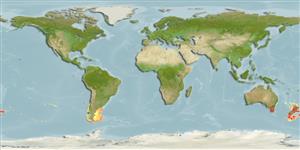Classification / Names
Common names from other countries
Main reference
Size / Weight / Age
Max length : 65.0 cm SL male/unsexed; (Ref. 27363); common length : 40.0 cm SL male/unsexed; (Ref. 27363); max. published weight: 6.0 kg (Ref. 27363); max. reported age: 12 years (Ref. 31614)
Environment
Marine; pelagic-neritic; depth range 1 - 800 m (Ref. 9563), usually 1 - 200 m (Ref. 75154)
Climate / Range
Temperate, preferred 13°C (Ref. 107945); 33°S - 60°S, 140°E - 57°W
Distribution
Southwest Pacific: southern Australia and New Zealand (Ref. 9002). Southeast Pacific: Chile, including the Juan Fernandez Islands. Southwest Atlantic: Argentina.
Countries | FAO areas | Ecosystems | Occurrences | Introductions
Short description
IUCN Red List Status (Ref. 115185)
Threat to humans
Harmless
Human uses
Fisheries: commercial
More information
Common namesSynonymsMetabolismPredatorsEcotoxicologyReproductionMaturitySpawningFecundityEggsEgg development
Tools
Special reports
Download XML
Internet sources
Estimates of some properties based on models
Phylogenetic diversity index
PD50 = 0.5156 many relatives (e.g. carps) 0.5 - 2.0 few relatives (e.g. lungfishes)
Trophic Level
3.2 ±0.33 se; Based on food items.
Resilience
Medium, minimum population doubling time 1.4 - 4.4 years (Assuming tm=3-4)
Vulnerability
Moderate to high vulnerability (48 of 100)
Price category
